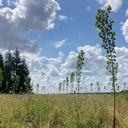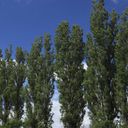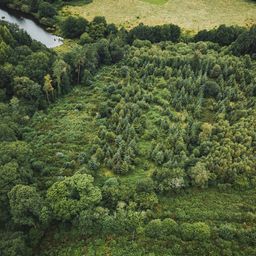
Black Cottonwood: Characteristics, use and symbolism
Black Cottonwood, a fast-growing tree, is used for reforestation and soil stabilisation, while playing an important ecological role in protecting riverbanks and forest ecosystems.
Balsam Poplar
Black Cottonwood, or Populus balsamifera, is a species of poplar belonging to the family Salicaceae, which is widespread in North America. Known for its rapid growth and ability to colonise damp environments, this tree is characterised by its lance-shaped leaves, resinous buds with a characteristic balsamic odour, and grey bark that cracks with age. Black Cottonwood also plays an important role in reforestation projects and soil stabilisation, particularly in riparian and marshy areas.
Why does EcoTree plant Black Cottonwood?
Black Cottonwood is a fast-growing species. It is therefore of interest in reforestation projects to regenerate degraded forests or to stabilise soils after clear-cutting. Its ability to occupy space quickly helps to protect soils against erosion and rapidly restore vegetation cover.
It also shows a certain resilience to natural disturbances such as forest fires. Its ability to regenerate through stump sprouting (the growth of new shoots from the roots) means that the forest can recover more quickly from these disruptive events.
In mixed forests, Black Cottonwood can coexist with other species such as Maples or conifers.
Balsam Poplar - Overview
Balsam Poplar - Overview

Balsam Poplar - Species requirements
This tree thrives in wet soils, particularly in riparian areas such as marshes, riverbanks and flood valleys. It can play an important role in regulating wetland ecosystems by helping to stabilise banks and improve water quality. It is therefore worth incorporating it into wetland restoration projects.
However, it does not tolerate soils that are constantly saturated with water or that lack drainage, as this can lead to root rot.
It prefers sunny exposures. Good access to light is essential for rapid growth.
Black Cottonwood is generally resistant to many diseases and pests, although it can be prone to certain problems such as defoliating insects or fungal diseases.
Black Cottonwood's Wood
Black Cottonwood is often used to produce pulp. Its soft, fibrous wood is ideal for making newsprint, corrugated board and other types of paper for everyday use. Its long fibre provides good strength for products such as cardboard.
Although Black Cottonwood is not as strong as species such as Oak or Pine, it is still used for lumber in applications requiring lightweight wood, such as light framing, mouldings and some cladding. In general, it is used where high mechanical strength is not required.
Although not directly related to the industrial use of wood, it is interesting to note that its resin and bark have historically been used in traditional Amerindian medicine for their anti-inflammatory and antiseptic properties. They are sometimes used to make balms or poultices.
Black Cottonwood's symbolism
In certain beliefs, particularly among the indigenous peoples of North America, Cottonwoods are seen as trees that communicate with spirits or ancestors. The constant rustling of their leaves could be interpreted as whispers or messages from the afterlife. The Balsam Poplar may therefore symbolise a connection with the spiritual world and the memory of ancestors.
It is also considered a protective and healing tree. Its leaves, buds and resin were used for their medicinal properties. So it is seen as a tree of care and protection, both physically and spiritually.
Our selection of trees
Our goal is to enable anyone to do something that benefits nature and helps us to live in a more harmonious world. So why not become a tree owner in a European forest and help combat climate change?






Please note that this is promotional communication. See our notice of information.







